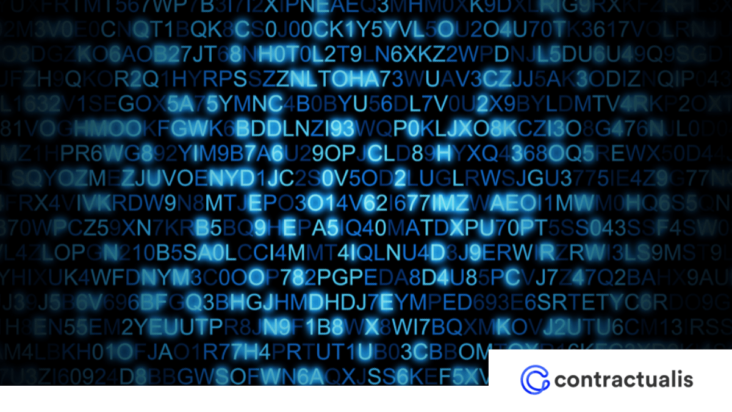In today’s digital world, where information is constantly managed and shared, document security is essential. Digital signatures and security algorithms are key to safeguarding the integrity and authenticity of information, especially in legal and business settings. One of the most trusted algorithms for ensuring this level of security is the SHA-256 algorithm for document security, which provides a unique “digital fingerprint” for each file.
In this article, we’ll explain how this algorithm works, why it’s essential for document security, and how platforms like Contractualis use it to guarantee the integrity of digitally signed documents.
What is the SHA-256 Algorithm?
SHA-256, which stands for Secure Hash Algorithm 256-bit, is a type of cryptographic function that transforms a file or message into a 64-character alphanumeric sequence. This sequence is known as a “hash” or “digital fingerprint,” and any change, no matter how small, in the original file will generate a completely different fingerprint.
The most relevant feature of the SHA-256 algorithm is its high resistance to collisions, meaning it’s extremely unlikely that two different documents will generate the same hash. This level of security is crucial in environments where sensitive data is handled, such as legal documents and digital contracts.
How Does the SHA-256 Algorithm Work?
SHA-256 transforms information through a complex mathematical process into a 256-bit digital fingerprint. The algorithm accepts any document or file as input, regardless of its size, and converts it into a fixed 256-bit string. One advantage of SHA-256 is its “avalanche effect”: any change to the original file, even a single character, creates a completely different digital fingerprint.
This feature is invaluable for document security. By having a unique digital fingerprint, it’s possible to detect any alteration to the original document. Additionally, due to the complexity of this algorithm, it is extremely difficult (if not impossible) to predict the hash or recreate the original document from the fingerprint.
Uses of the SHA-256 Algorithm in Document Security
The SHA-256 algorithm for document security is used across various applications and industries, especially those requiring data integrity. In the legal and contractual domain, SHA-256 is widely used to create digital fingerprints for contracts, notarized documents, and other critical files. Common uses include:
- Authenticity Verification: By applying SHA-256 to a document, a unique hash can be generated, which can be used to verify its authenticity. If the hash of the received document matches the expected hash, the file is guaranteed to be unaltered.
- Protection Against Tampering: Once a file is processed with SHA-256, any later modification will alter its hash, revealing that the document has been tampered with.
- File Transfer Security: When sending digital documents, it’s common to attach the hash so the recipient can verify the file wasn’t altered during transfer.
- Digital Signature: Digital signature systems and contract management platforms, such as Contractualis, use SHA-256 to generate digital fingerprints for signed documents. This ensures that the document content cannot be modified without invalidating the digital signature.
Why is the SHA-256 Algorithm Important for Document Security?
SHA-256 is considered one of the most secure and reliable algorithms, in part because it belongs to the SHA-2 family of algorithms, developed by the United States National Security Agency (NSA). Its importance lies in its ability to provide integrity and security without compromising data confidentiality.
The SHA-256 algorithm for document security enables the creation of unique identifiers that act as “digital fingerprints” for documents. This feature is crucial in preventing fraud and data tampering, as it guarantees that any attempt to alter a document will be detected. By generating unique and consistent hashes, SHA-256 provides an effective tool for securing digital contracts, legal documents, and any other highly sensitive files.
Implementing the SHA-256 Algorithm in Contractualis
Contractualis.com, a platform specialized in managing digital contracts and documents, implements the SHA-256 algorithm for document security, particularly in its digital signing process. By using this algorithm, Contractualis generates a unique digital fingerprint for every document signed on its platform. This not only ensures that the document’s content remains unchanged but also facilitates its authenticity verification at any time.
For example, when a document is signed on Contractualis, a hash is generated through SHA-256 and stored along with the document. In this way, any later modification will be recorded, as the original hash won’t match the hash of the modified document. This adds an extra layer of security that protects both companies and individuals managing digital contracts.
The SHA-256 algorithm is a key tool in the digital age, especially for managing sensitive documents. Its ability to generate unique digital fingerprints allows for the detection of any alteration, protecting information integrity and guaranteeing authenticity.
At Contractualis, this technology is a fundamental part of the digital signing process, providing users with the confidence that their documents will be protected and remain unchanged over time. Thanks to SHA-256, documents signed on the platform have an extra layer of security essential for safeguarding important contracts and agreements.
If you want to learn more about optimizing the security of your legal documents, we invite you to read our article on the legal benefits of using digital signatures in contracts.
